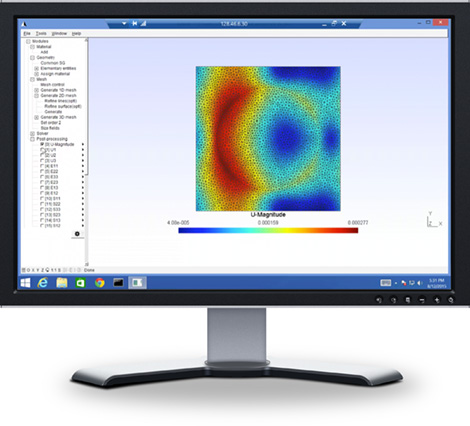
Operate with Efficiency
SwiftComp is a revolutionary multiscale, multiphysics composite simulation code that quickly and easily delivers the accuracy of 3D FEA at the efficiency of simple engineering models. In doing so, SwiftComp reduces barriers for engineers by enabling them to model composites as easily as metals using conventional structural elements in their FEA codes (without losing accuracy while capturing all the microstructural details). SwiftComp provides unified modeling for 1D (beams), 2D (plates/shells), or 3D structures, calculating all the effective properties. Use SwiftComp either independently for virtual testing of composites or as a plug-in to power your conventional structural tools with high-fidelity composites modeling. SwiftComp can compute the best structural model for use in macroscopic structural analysis, as well as perform dehomogenization to compute the pointwise stresses in the microstructure. SwiftComp directly interfaces with ABAQUS, ANSYS (Workbench, Classical), MSC.Patran/Nastran and others. Due to its general-purpose nature, SwiftComp has been used to simulate everything from high strain composites in deployable space structures to printed circuit boards (PCBs) to high-end fishing rods. In addition to composites, SwiftComp provides novel simulation capabilities for metamaterials, architected materials, porous materials, tailorable composites, and many more (honeycomb sandwich structures, etc.). The latest version, SwiftComp 2.1, adds many new capabilities, including the prediction of viscoelastic properties, thermoviscoelastic properties and composites failure, as well as AI-assisted composites simulation.
SwiftComp is much more than a micromechanics tool for composites. SwiftComp has the additional capability to compute equivalent structural properties for composite beams, plates, shells, and 3D solid structures, which is not available in conventional approaches. Furthermore, SwiftComp is not your typical homogenization technique. Instead, it actually unifies structural mechanics and micromechanics to provide a direct connection between structures and materials. The traditional approach of treating materials and structures separately can sometimes lead to significant errors in results.
How is SwiftComp Different?
Because SwiftComp directly and seamlessly links detailed microstructure and structural behavior for composite structures including beams, plates/shells, and 3D structures, it allows the user to decide which scale to start and which scale to end. For example, SwiftComp can take lamina properties as input to compute effective plate/shell properties for stiffened panels or sandwich structures with heterogeneous cores, or take fiber/matrix properties to compute torsional stiffness of a composite shaft. The unique feature of SwiftComp is to compute effective structural properties (3D solids, plates/shells, beams) in terms of whatever the user can provide as an input. For example, SwiftComp can model composite laminates similarly as the classical lamination theory without the traditionally used self-conflicting plane stress assumption and the Kirchhoff kinematic assumptions (effectively plane strain assumption).
Most micromechanics models are based on RVE (representative volume element) analysis. However, SwiftComp is different from a typical RVE analysis in the following ways, improving both accuracy and efficiency:
- SwiftComp computes 3D properties and local fields without multiple runs with multiple analysis.
- SwiftComp computes 3D properties and local fields using a 2D or 1D domain (RVE analysis usually needs a 3D domain).
- SwiftComp computes the complete set of 3D properties and local fields without applying multiple sets of boundary conditions.
- SwiftComp directly computes properties and stress fields for beams, plates and shells.
Latest Research with SwiftComp
AnalySwift works closely with federal agencies such as NASA, Navy and others through SBIR/STTR contracts to leverage SwiftComp’s unparalleled combination of efficiency accuracy to solve their evolving advanced materials simulation needs. These include finding solutions to modeling high strain composites, thin-ply composites, and tailorable composites (tow-steered composites, variable thickness composites, etc.). Learn more about these efforts here.
How can SwiftComp help you?
- Reduce engineering time by orders of magnitude for even the most complex composites.
- Infuse 3D FEA fidelity into earlier design stages at the efficiency of simple engineering models.
- Harness the full potential of composites in your design by capturing both anisotropy and heterogeneity.
- Power your conventional FEA packages with high-fidelity multiscale, multiphysics composites modeling.
- Simplify use of your composite simulation tools by unifying micromechanics and structural mechanics into a single technology.
2,000x FASTER
than 3D FEA for 4 layer cross-ply laminate
Get the SwiftComp Brochure
See the SwiftComp Brochure for details about features and capabilities.

SwiftComp Applications
AnalySwift’s software handles a wide variety of 1D, 2D, and 3D composite structures, enabling the virtual testing of composites for mechanical and multifunctional properties.
MULTISCALE, MULTIPHYSICS MODELING OF COMPOSITES
3D composite structures
- Binary composites
- Fiber reinforced composites
- Particle reinforced composites
- Textile composites
- Short fiber composites
- Porous materials
- Foams
- Other heterogeneous materials
2D Composite plates/shells
- Laminates
- Stiffened panels
- Corrugated structures
- Perforated structures
- Sandwich structures
- Unitized structures
- And more
1D Composite beams
- Helicopter rotor blades
- Wind turbine blades
- Propellers
- High-aspect wings
- Golf clubs
- Fishing rod
- And other slender composites structures
VIRTUAL TESTING OF COMPOSITES
Mechanical properties
- Elastic constants
- Static strength
Mechanical properties
- Conductivities
- Dielectric
- Magnetic
- Diffusive properties
- Coefficients of thermal expansion
- Specific heat
- Electromagnetic properties

Unique Technology
SwiftComp provides a seamless, high-fidelity link between constituent material properties and engineering structural design and analysis. To do so, SwiftComp implements the novel Mechanics of Structure Genome theory, which unifies composite micromechanical and structural modeling. SwiftComp differs drastically from the conventional micromechanics-then-structural mechanics approaches. By avoiding assumptions commonly invoked in other approaches, SwiftComp provides the most mathematical rigor and best engineering generality. The problem is decoupled into two sets of analyses: a constitutive modeling and a structural analysis, allowing the structural analysis to be formulated exactly as a general (1D, 2D, or 3D) continuum. This also confines all approximations to the constitutive modeling, ensuring the best accuracy. A video describing Mechanics of Structure Genome and SwiftComp can be found here.







